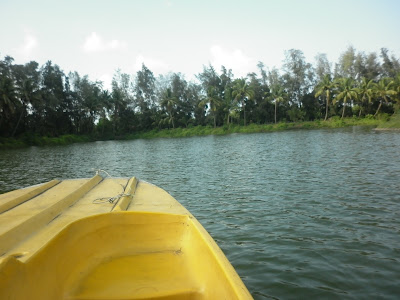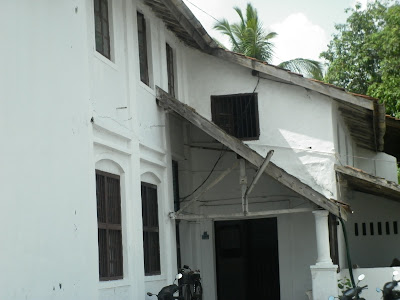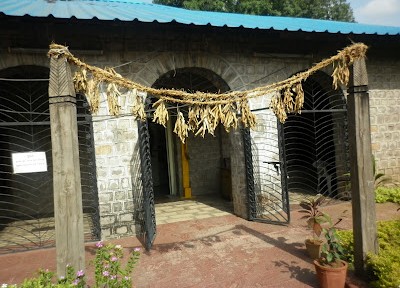We (my wife and I) recently went to Silvassa, the capital of Union Territory of Dadra and Nagar Haveli, the erstwhile Portuguese colonies, which joined the Indian state in 1961. My company has a Polyester Texturising Plant there. Lyn, my wife, went around in Silvassa looking at the parks, dams and lakes whilst I busied myself in my job. Silvassa, derives its name from the Portuguese word “
silva”, which means wood. Silvassa is just 180 kms from the concrete jungle called Mumbai and after this 3 hours drive on a very good six lanes NH8 you are transported to a rare sylvan beauty:
 |
| Madhuban dam built across river Daman Ganga |
 |
| A view of the Ban Ganga Lake |
The Madhuban Dam amd Ban Ganga Lake are great tourist attractions at Silvassa. Ban Ganga Lake is a paradise for nature lovers and its scenic beauty, serenity and lush verdure around it have inspired many scenes, especially song sequences in Hindi movies. The following pictures may trigger memories of those scenes:
 |
| Ban Ganga Lake – the scene of many songs from Hindi movies |
 |
| Lake, trees, and a boat….and that too sun coloured. What more do you want? Chand? |
 |
| Scene around Ban Ganga Lake – makes you break into a song |
 |
| 180 kms from Mumbai and you are one with Nature all by yourself |
 |
| And, if there is flora, fauna can’t be far, is it? |
 |
| Around Ban Ganga lake in Silvassa, you can go on a wild-goose chase and enjoy it |
 |
| You’d love being ashore…….. |
 |
| —–and love looking into water |
Adding to the scenic beauty is the Silvassa Museum or the Tribal Museum. It has some imaginative displays that give one glimpses into the tribal culture through a collection of masks, musical instruments, traditional jewelry and hunting tools. You can also see Warli paintings and traditional crafts and even buy this stuff. Have a look in the following pictures:
 |
| Entrance to the Silvassa Museum |
Some of the displays in the museum:
Alright, I must have already convinced you to visit Silvassa. There are Lion and Deer safaris to be had. The tourism brochure gives you a number of choices in eco-tourism, agri-tourism, tribal culture, wildlife, water sports etc. And all this is just 180 kms from Mumbai.
Thirty kms from Silvassa, on the other side of National Highway Number 8 between Mumbai and Ahmedabad is the Union Territory of Daman. Just like the UT of Dadra and Nagar Haveli, Daman too has an impressive entrance:
 |
| Entrance to the Union Territory of Daman |
Just as at the entrance of Dadra and Nagar Haveli, the tribal or indigenous people have been show-cased. This statue of a fisherman greets you at the entrance:
 |
| Memorial to the common man – a fisherman at the entrance to Daman |
A Portuguese Diogo de Melo arrived at Daman, by chance in 1523, when heading towards Ormuz but caught in a violent storm and having his boat blown towards the coast of Daman. Soon the other Portuguese arrived and made it into a Portuguese colony. It remained so till its merger into Indian state as a Union Territory in 1961 when a pitched battle took place between the Indians and the Portuguese that left four Indian and ten Portuguese dead and more than a dozen wounded. Just a km from the entrance is a monument of the multi-masted ships that the Portuguese used that gave them more speed and maneuverability than the Indian or Arab craft with a single mast. Hence, they were able to overpower the indigenous Indians or the Moghuls that ruled over great parts of India. The neglect of the sea-power in India led to our subjugation. However, until recently this simple fact escaped our collective attention. Portugal didn’t recognise the merger or annexation of Daman with India until 1974, one year after I had joined the Indian Navy.
 |
| Multi masted ship, a symbol of Portuguese sea power |
Daman is divided by the Daman Ganga River into two parts namely Nani Daman (Nani means “small”) and Moti Daman (Moti means “big”). We entered through the Moti Daman and in our fleeting visit, as given in the title, we didn’t go across the bridge to Nani Daman. We were also told that despite its name, Nani Daman is the bigger of the two [parts of Daman and has shopping complexes, residences and other public utilities. Moti Daman, on the other hand turned out to be quiet, sleepy, devoid-of-activity town.
 |
| The bridge between the two Damans – Nani (small) and Moti (large) |
Earlier there were two bridges; one for light vehicles and other for four-wheelers and above. The light bridge collapsed in Aug 2004 killing 8 school children. It was re-built but hat two collapsed. In addition to the sole bridge now, there are small boat ferries between the two Damans.
 |
| The ferry points on either side are visible |
 |
| The river side memorial |
Soon after the Portuguese arrived, they built a fort in Moti Daman to guard against the Mughals who were in the area before the Portuguese. You can see from the pictures below that the fort still stands after four centuries. It is lit at night.
 |
| Photo taken at the river side resort and showing the entrance to the Fort |
As we started going around the fort from the North side, we say the black and white painted Lighthouse through he fishing boats. The Lighthouse has a radar above it.
We started our journey along the outer wall of the fort towards Westwards.
And very soon we reached the lighthouse:
 |
| The Daman lighthouse with radar antenna atop it |
 |
| The old lighthouse inside the fort |
 |
| Travelling south from the new lighthouse with is entrance |
 |
| Going along the south side of the fort |
 |
| The villagers next to the fort – predominantly Hindu |
 |
| Another view of the fort |
 |
| Back to the other entrance – ie, the South entrance |
The total population of Daman is still less than a lakh. Its literacy rate is 76 percent, which is better than the rest of India. Most of the population in Daman consists of skilled and educated migrant workers (from all over India) who reside in Daman for a period of around 4 to 5 years. The local population consists of mostly fishermen called Tandels in Gujarati. The major part of the population is a mixture of Hindus, Muslims and Christians, with Hindus being dominant in number. There has never been any communal violence reported in this area. Unlike Goa, you don’t find ubiquitous crosses, niches with Mother Mary and Jesus statues and chapels everywhere. On the other hand there are temples, the most popular being Satya Narayan’s.
 |
| There are many temples in Daman |
The Portuguese history of Daman, which has given it the present unique lifestyle, still revolves around Roman Catholicism. Surprisingly, two out of the three famous churches that we visited are still in use. First we visited the Church of Bom Jesus. Here is from Wikipedia, “This early 17th Century church dedicated to Bom Jesus is one of the most impressive holy places in Daman. It was completed in its present form in 1603 AD and is a living tribute to the excellence achieved by Portuguese architects and artisans in ornate and intricate Church buildings. The richly carved doorway and the highly, decorated interiors together with the lofty ceiling are aesthetic and pleasing. There are six finely made statues in the best traditions of Roman Church art and architecture. In early days of the Portuguese rule, Bom Jesus was a parish church. The Church now attracts both tourists and pilgrims in large numbers”. You can also read some history from this signage:

Whilst structures that are made of stone are still in good condition elsewhere in the country (especially of ancient Hindu temples), it was nice to see a brick and mortar structure still standing with its old glory:
 |
| The facade of the 1603 church of Bom Jesus in Moti Daman |
 |
| Garden between the church and the old Collectorate |
 |
| Another old Portuguese building – now a government office |
Because of this being a hurried visit, we missed seeing the Chapel of Our Lady of Rosary, also built during the beginning of the 17th century. However, what we saw was the Church of The Lady of Remedies. Its beauty left us gasping for breath. It is partly Gothic and partly Byzantine and has beautiful interior and original frescoes. Please look at the following pictures; the church is currently in service:
 |
| Description of the church both in Hindi and English |
 |
| Facade of the Church of The Lady of Remedies |
 |
| The church building: typically Iberian |
 |
| The ornate interior of the church |
 |
| Painting dating back four centuries |
 |
| Exquisitely carved pulpit |
 |
| A fresco dating back to 1607 |
 |
| The stone at the altar dating back to 1816 |
 |
| Altar |
 |
| Towards left of the altar |
 |
| And to the right |
 |
| One of the doors of the church |
 |
| Another door |
 |
| Church bell |
 |
| Right exterior of the church |
 |
Left wall of the church and the only addition to the church after Portuguese left
that is, the memorial hall on left |
 |
| Inscription on the memorial hall |
The other places that we visited are:
 |
| The new Secretariat building inaugurated by Sh PM Sayeed, Union Minister of State for Home in 1993 |
 |
| The new Collectorate |
 |
| A memorial at the park close to the Secretariat |
What we didn’t see was the vibrant life at the beaches of Daman during the weekends, the night clubs, casinos, spas etc. Easy availability of cheap liquor has made Daman as the quick get-away for people especially Gujaratis who are otherwise denied liquor due to prohibition. Daman attracts frequent tourists from Vapi, Bhilad, Valsad, Surat and even Vadodara. The two well known beaches of Daman are Devka beach in Nani Daman and Jampore beach at the entrance of Moti Daman. One passing thought: if ACP Dhoble has his way, very soon we may have even Mumbaiites travelling all of 200 kms to be at Daman to a watering-hole.

Had no idea about the POrtugese connection in Daman and Diu. Nice pics 🙂
A nice travelogue
Thank you Jaswant
nice photography
Thanks